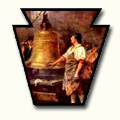|
132 CLEARFIELD COUNTY - PRESENT AND
PAST
The Iddingses kept the "station" in Center county, and
the Moores the principal one in the Grampian Hills, though others helped the
runaways.
THE EFFECTS OF WARS ON THE COUNTY
The World War. Nearly 2,000 men volunteered, and about
3,000 were inducted into the service by the three Exemption Boards, making in
all around 5,000 from the county. The first men were sent in September 19, 1917.
188 men died in the service.
The first registration was June 5, 1917. It included
men from 21 to 31 years of age and aggregated 8,400, of whom three-fifths were
foreign born and one-seventh aliens.
The second registration, June 5, 1918, was of about 800
who had become 21 years old since the first registration date.
The third registration, September 12, 1918, included
ages 18 to 40, of whom there were 12,000. The total registrations totaled about
21,200.---From information received from John Bain, Secretary Clearfield
Exemption Board.
The effects of the World War at the time was
stimulation of nearly every branch of industry in the county.
Being a great mining county, there was a phenomenal
development of mines both of coal and clay, many new mines being opened and old
ones operated to capacity.
The extension of electrical equipment to mines was
rapid, so that electric lines were run over the county in every direction to
operations, and also many smaller towns and farms were thus incidentally and
suddenly put in reach of light and power. Soon there was work for everybody at
high wages and the money thus put in circulation began to be spent lavishly by
those who,never having had so much before, had little idea of how to use it for
their own best interests.
So an orgy of spending came about, extending from silk
shirts at 6 to 15 dollars and ladies shoes up to $15 a pair, to automobiles and
costly furs galore.
|






